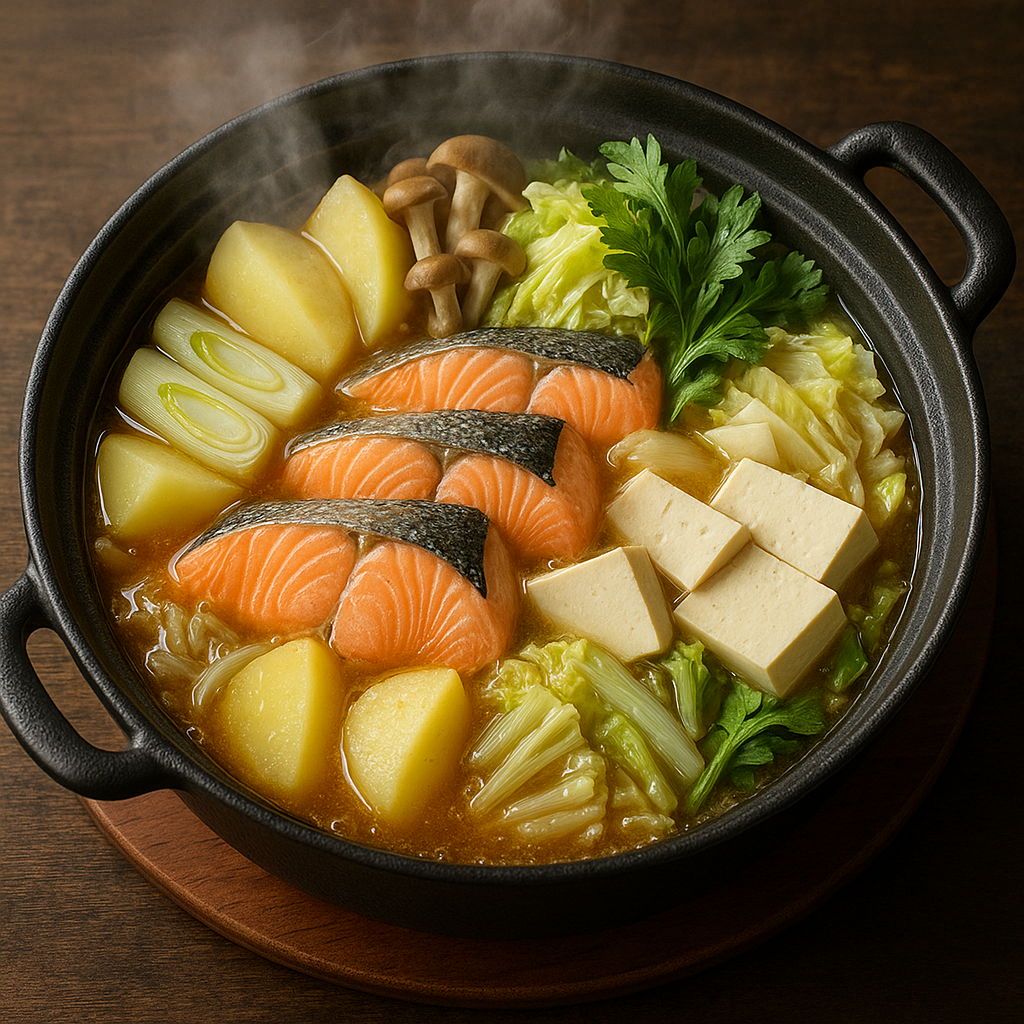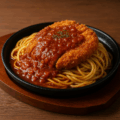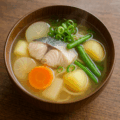石狩鍋の特徴
鮭を主役にした郷土鍋
石狩鍋は、北海道石狩地方で誕生した郷土料理で、新鮮な鮭を主役にした鍋料理です。大ぶりに切った鮭の身やアラを豪快に使うのが特徴です。
味噌仕立てのスープ
昆布出汁をベースにしたスープに味噌を溶き、野菜と鮭の旨味を合わせます。北海道らしい濃厚で温かみのある味わいが楽しめます。
豊富な具材
鮭のほか、白菜・長ネギ・大根・人参・じゃがいも・豆腐などが入り、栄養バランスに優れた一品です。
石狩鍋のレシピ
材料(4人分)
- 生鮭(切り身) … 4切れ
- 白菜 … 1/4株
- 長ネギ … 2本
- 大根 … 1/4本
- 人参 … 1/2本
- じゃがいも … 2個
- 豆腐 … 1丁
- 昆布 … 10cm角1枚
- 水 … 1000ml
- 味噌 … 大さじ4〜5
- 酒 … 大さじ2
- みりん … 大さじ1
作り方
- 鍋に水と昆布を入れ、出汁をとる。
- 野菜を食べやすい大きさに切り、じゃがいもは軽く下茹でする。
- 出汁に鮭を入れ、アクを取りながら酒を加える。
- 野菜・豆腐を加えて煮込み、みりんと味噌を溶き入れる。
- 仕上げにネギを散らし、熱々をいただく。
シェフのワンポイントアドバイス
鮭のアラを一緒に煮込むと、旨味がより濃厚になります。
お好みでバターや牛乳を少量加えると、まろやかでコクのある味わいに仕上がります。
塩鮭を使うと三平汁になります。
石狩鍋の栄養価(1人分の目安)
- エネルギー:約400〜500 kcal
- たんぱく質:25〜30 g
- 脂質:10〜15 g
- 炭水化物:40〜50 g
- ビタミンD・B群(鮭由来)
- 食物繊維・ビタミンC(野菜由来)
- EPA・DHA(鮭由来)
低カロリーで栄養バランスがよく、体を温める冬に最適な鍋料理です。
石狩鍋の歴史
漁師のまかないから誕生
石狩鍋は、明治時代に北海道石狩地方の漁師が、獲れたての鮭を鍋で煮て食べたのが始まりといわれています。
味噌仕立ての理由
寒冷な北海道で保存性と栄養を考慮し、味噌を加えることで体を温め、力をつける料理となりました。
郷土料理としての定着
家庭料理から観光客向けの名物へと発展し、現在では北海道を代表する郷土料理のひとつとして知られています。
English Version
Features of Ishikari Nabe
A Local Hot Pot with Salmon as the Star
Ishikari Nabe is a traditional hot pot dish that originated in the Ishikari region of Hokkaido. It features fresh salmon, often cut into large chunks or using the head and bones for extra flavor.
Miso-Based Broth
The broth is made with kombu dashi (kelp stock) combined with miso, bringing together the flavors of vegetables and salmon. It offers a rich and warming taste typical of Hokkaido cuisine.
Variety of Ingredients
Along with salmon, common ingredients include Chinese cabbage, green onions, daikon radish, carrots, potatoes, and tofu, making it a nutritionally balanced dish.
Recipe
Ingredients (for 4 servings)
- Fresh salmon (fillets) … 4 pieces
- Chinese cabbage … 1/4 head
- Green onions … 2 stalks
- Daikon radish … 1/4
- Carrot … 1/2
- Potatoes … 2
- Tofu … 1 block
- Kombu … 1 piece (10 cm square)
- Water … 1000ml
- Miso … 4–5 tbsp
- Sake … 2 tbsp
- Mirin … 1 tbsp
Instructions
- Place water and kombu in a pot to make dashi (stock).
- Cut vegetables into bite-sized pieces; parboil the potatoes.
- Add the salmon to the broth, skim off any scum, and add sake.
- Add vegetables and tofu, then stir in mirin and miso.
- Finish with chopped green onions and serve hot.
Chef’s Tip
Adding salmon bones (ara) deepens the broth’s flavor. A small amount of butter or milk can be added for a richer, milder taste. If salted salmon is used, the dish becomes similar to Sanpeijiru, another Hokkaido specialty.
Nutritional Value (per serving, approx.)
- Calories: 400–500 kcal
- Protein: 25–30 g
- Fat: 10–15 g
- Carbohydrates: 40–50 g
- Vitamin D & B group (from salmon)
- Dietary fiber & Vitamin C (from vegetables)
- EPA & DHA (from salmon)
A low-calorie, nutritionally balanced hot pot that warms the body, making it ideal for winter.
Historical Background
Born from Fishermen’s Meals
Ishikari Nabe is said to have originated in the Meiji era, when fishermen in the Ishikari region cooked freshly caught salmon in a hot pot.
Why Miso Was Used
In cold Hokkaido, miso was used for its nutritional value and preservability, as well as for its warming effect.
Established as a Local Specialty
From home cooking to a well-known tourist specialty, Ishikari Nabe has become one of Hokkaido’s most famous local dishes.



何でも質問してください!